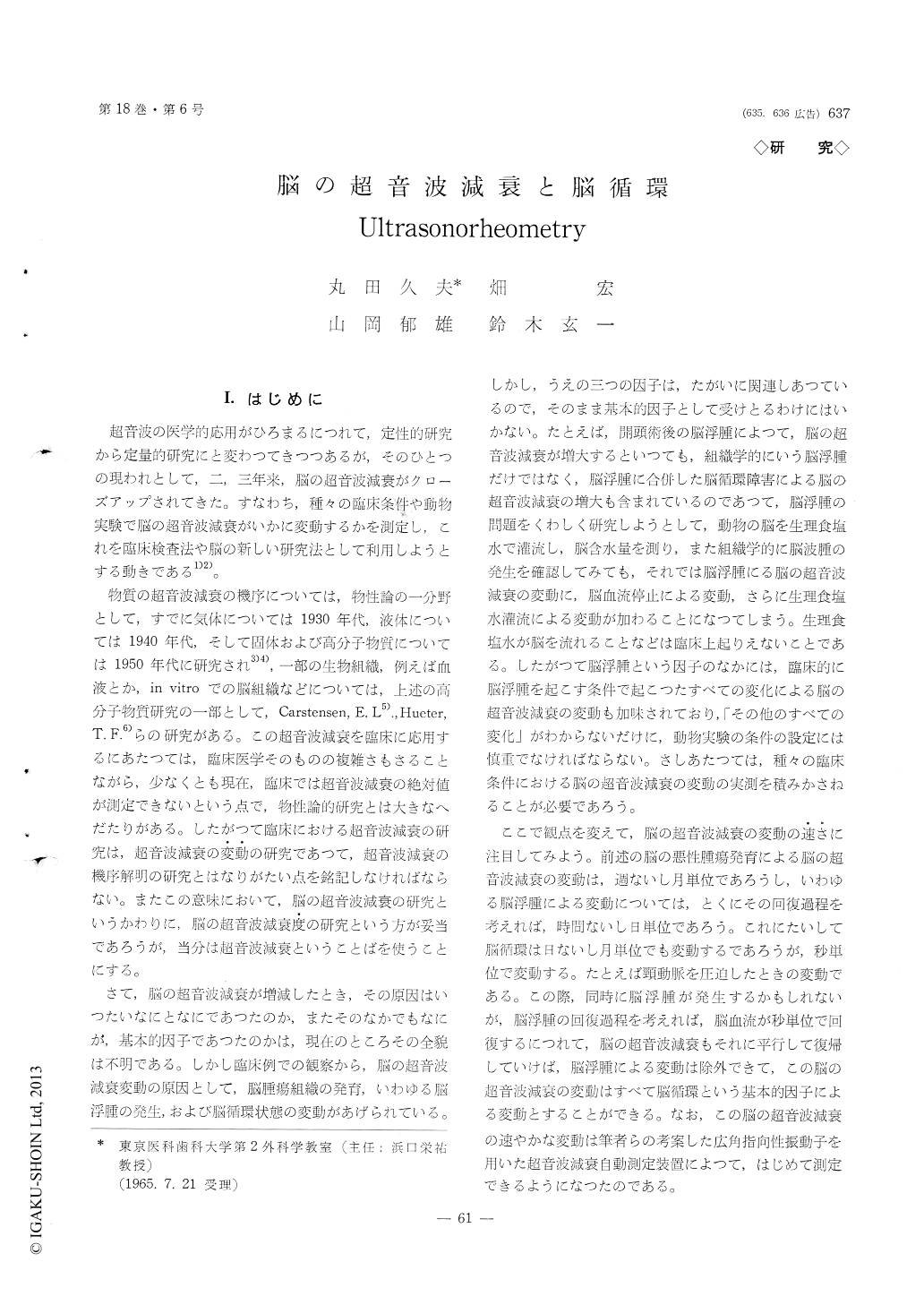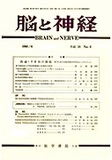Japanese
English
- 有料閲覧
- Abstract 文献概要
- 1ページ目 Look Inside
I.はじめに
超音波の医学的応用がひろまるにつれて,定性的研究から定量的研究にと変わつてきつつあるが,そのひとつの現われとして,二,三年来,脳の超音波減衰がクローズアップされてきた。すなわち,種々の臨床条件や動物実験で脳の超音波減衰がいかに変動するかを測定し,これを臨床検査法や脳の新しい研究法として利用しようとする動きである1)2)。
物質の超音波減衰の機序については,物性論の一分野として,すでに気体については1930年代,液体については1940年代,そして固体および高分子物質については1950年代に研究され3)4),一部の生物組織,例えば血液とか,in vitroでの脳組織などについては,上述の高分子物質研究の一部として,Carstensen, E.L5),Hueter,T.F.6)らの研究がある。この超音波減衰を臨床に応用するにあたつては,臨床医学そのものの複雑さもさることながら,少なくとも現在,臨床では超音波減衰の絶封値が測定できないという点で,物性論的研究とは大きなへだたりがある。したがつて臨床における超音波減衰の研究は,超音波減衰の変動の研究であつて,超音波減衰の機序解明の研究とはなりがたい点を銘記しなければならない。またこの意味において,脳の超音波減衰の研究というかわりに,脳の超音波減衰度の研究という方が妥当であろうが,当分は超音波減衰ということばを使うことにする。
1) Introduction
Under the various clinical conditions such as in cases of head injuries, dumping syndrome and during general anesthesia, the ultrasonic attenuation of hu. man brain (cerebral ultrasonic attenuation, C.U.S.A.) had been found to change as if the C. U. S. A. shoulc reflect the cerebral blood flow change. This study was designed to measure the blood flow change using C. U. S. A.
2) Method Measurement of the C. U. S. A.
Principle : The ultrasonic reflection method using the pulse wave of 1. 0 MC. A new procedure, within the error of 0.1 db, for automatic and continuous measurement of C. U. S. A. had been devised using the gating system and the ultrasonic transducer with -Wide Beam Searchlight Pattern (sphericalshell, 10φ30 R).
Measurement of the cerebral blood flow .... The unilateral internal carotid flow was measured with the electromagnetic flow meter of AVIONICS Model 6000.
Materials : Ten adult dogs weighing 10-18 kg. were anesthe tized with thiopenthal sodium and their internal carotid artery were exposured. Giving the acetylcholin of 10-50 γ/kg. intravenously, the cardiac output were temporarily decreased, which led to diminish the in-ternal carotid flow and other arterial blood supply to the brain. The C. U. S. A. and the internal carotid flow were measured simultaneously.
3) Results
There were evident linear relation between the C. U. S. A. and the internal carotid flow (cerebral blood flow) so much as the cerebral blood flow change was from -20% to +40%. The results could be express-ed as follows,
fi=83 a, r = 0.97
fi: decrease of cerebral boold flow (%)
ai: the C. U. S. A. change (db)
Finding the C. U. S. A., the cerebral blood flow change could be calculated on the formula.
4) Discussion
Clinical application
The experiments above mentioned, can not be performed clinically. P. Scheinberg had reported that when adults were tilted to the angle of 65, the cereb-ral boold flow was decreased as much as 21%. On the same experiments. the C. U. S. A. was increased on an average 3 db.
It might be true that there were linear relation between the ultrasonic attenuation of human brain and the cerebral blood flow change. Thus the formula wax expressed as follows,
F (%) =7 A (db)
This method of measuring cerebral blood flow change by C. U. S. A. was something resembled to "Rheoencephalograph", which measured by the im-pedance of the brain. Our method, however, was superior to the "Rheoencephalograph" at the point of little errorneous affection from external carotid flow. The error was calculated as follows,
df <0. 02|fi-fe|
fi: internal carotid flow change
(cerebral blood flow change)
fe external carotid flow change
5) Conclusion
The entirely new method, which measured the cerebral blood flow change continuously without any hazard, and only with an error of less than 2% was established and named "Ultrasonorheometry".

Copyright © 1966, Igaku-Shoin Ltd. All rights reserved.


